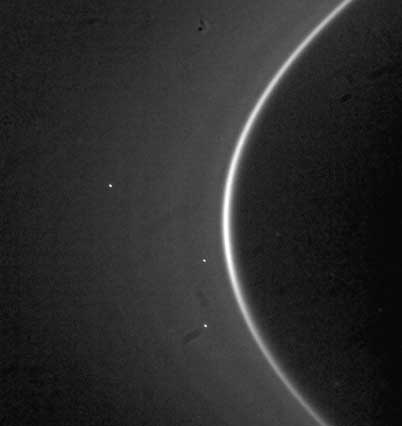05 August 2007

Credit: NASA/JPL/Space Science Institute
Analyzing data acquired by the Saturn-bound Cassini spacecraft, NASA scientists may have identified the source of an enigmatic Saturnian ring. Saturn's G ring is probably generated by relatively large, icy particles that reside within a bright arc on the ring's inner edge.
The particles are confined within the arc by the gravitational influence of Saturn's small moon Mimas (approximately 400 km across). Micrometeoroids collide with the particles, ejecting smaller, dust-sized particles that brighten the arc. The plasma (electrically charged gas) in Saturn's magnetic field sweeps through this arc continually, dragging out the fine particles, which form the G ring.
The finding indicates the complex interaction between Saturn's moons, rings and magnetosphere. Studying this interaction is one of the Cassini mission's objectives. The study appears in the 2 August issue of the journal Science and was based on data acquired by multiple Cassini instruments in 2004 and 2005.
"Distant pictures from the cameras tell us where the arc is and how it moves, while plasma and dust measurements taken near the G ring tell us how much material is there," said Matthew Hedman, a Cassini imaging team associate at Cornell University, and a principal author of the Science article.
The origin of Saturn's magnificent rings is a mystery. The rings are labeled in order of discovery. From Saturn outward, they are D, C, B, A, F, G and E. The three main rings, the A, B and C rings would fit neatly in the space between Earth and the Moon. The transparent D ring is interior to the C ring. The F, E and G rings lie outside the main rings. The outer diameter of the E ring is approximately 950,000 km.
Further Reading
JPL
www.jpl.nasa.gov/
Cassini-Huygens Mission
http://saturn.jpl.nasa.gov/home/index.cfm
Aymen Mohamed Ibrahem
Senior Astronomy Specialist